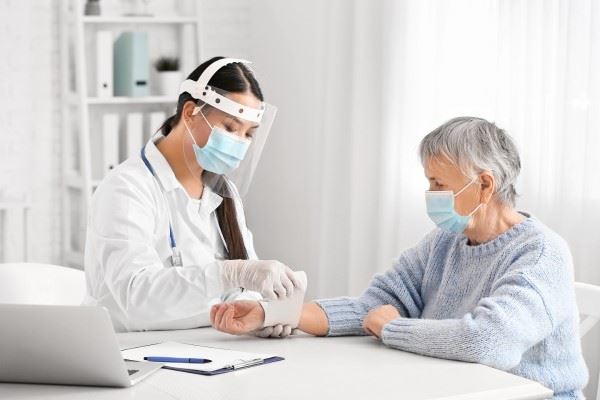-
Home
-
The Essential Guide to Wound Management
The Essential Guide to Wound Management
December 28, 2023
 Wound management is a crucial aspect of healthcare that involves the diagnosis, treatment, and prevention of wounds. Nurses and doctors play a vital role in wound management, as they are responsible for assessing the severity of the wound and providing appropriate treatment. Patients also play an active role in wound management by monitoring their wounds for signs of infection and following a prescribed treatment plan.
Wound management is a crucial aspect of healthcare that involves the diagnosis, treatment, and prevention of wounds. Nurses and doctors play a vital role in wound management, as they are responsible for assessing the severity of the wound and providing appropriate treatment. Patients also play an active role in wound management by monitoring their wounds for signs of infection and following a prescribed treatment plan.
Acute vs Chronic Wounds
Acute wounds result from specific incidents—such as cuts, burns, or surgical incisions—and adhere to a conventional and predictable healing trajectory. These wounds undergo the customary phases of hemostasis, inflammation, proliferation, and remodeling.
Chronic wounds persist over an extended period and deviate from what is considered the normal healing process. Chronic wounds are frequently associated with underlying health issues, including diabetes, vascular disorders, or infections. Prolonged healing times are compounded by complications such as persistent inflammation, impaired tissue repair, and an increased susceptibility to infections.
While acute wounds generally follow a straightforward healing process, chronic wounds demand a nuanced and multifaceted approach, addressing both the wound and underlying health conditions. A comprehensive understanding of the differences between these wound types is essential for healthcare practitioners, guiding tailored interventions, treatment options, and management strategies.
Steps in Effective Wound Management
While every individual situation requires specialized care, there are some basic principles for healthcare professionals to follow when managing a patient’s wound.
- Assessing the wound - When assessing a wound, it is important to carefully examine the area for any signs of infection, such as redness, swelling, or discharge. Additionally, noting the cause, size, depth, and location of the wound can provide valuable information for proper treatment and healing.
- Identifying any underlying conditions that could hinder wound healing - By thoroughly examining the individual's medical history, conducting comprehensive evaluations, and considering factors such as chronic illnesses, nutritional deficiencies, or compromised immune function, healthcare professionals can develop targeted treatment plans to optimize wound healing outcomes.
- Cleaning the wound gently to avoid tissue damage and irritants - When cleaning the wound, it is important to handle it gently in order to avoid causing any damage to the surrounding tissue or introducing any potential irritants that could hinder the healing process. This step is important to help prevent wound infection and remove any foreign bodies from the affected area.
- Choosing the appropriate wound dressing - The appropriate wound dressing plays a vital role in promoting healing, preventing infection, and maintaining a moist environment conducive to the recovery process. Consider factors such as the type and severity of the wound, as well as individual patient needs, to choose a dressing that will ensure adequate conditions for wound healing.
- Applying the dressing to the wound - Gently and carefully apply the dressing from the edges of the wound, ensuring that it covers the affected area completely and provides a protective barrier for proper healing and prevention of infection.
- Monitoring the wound for progress or complications - Regularly monitoring the wound for progress and potential complications is crucial for ensuring proper healing. By carefully observing any changes in size, color, or texture, as well as checking for signs of infection or delayed healing, healthcare professionals can take necessary interventions to promote optimal recovery and prevent further complications. This is especially important for patients with a high risk of infection or for those who have underlying conditions that may interfere with wound healing.
Basic Wound Care Instructions at Home
When it comes to wound care instructions, the primary goal is to keep the wound clean and dry. Some basic steps to help prevent infection include:
- Wash your hands before and after handling the wound
- Clean and irrigate the wound regularly as per your healthcare provider's instructions
- Keep the wound dry and avoid soaking it in water
- Do not pick at the scab or wound
- Keep an eye out for signs of infection, such as redness, swelling, and fever
Telling If a Wound is Healing or Infected
One of the key aspects of wound management is determining whether a wound is healing or is infected. Some signs of a healing wound include decreased pain, smaller wound size, fewer dressing changes required, and formation of granulated tissue. On the other hand, signs of an infected wound include redness and swelling, increasing pain, pus drainage, or a fever.
General Management of Wounds
By following the wound care instructions provided by healthcare providers and staying on top of wound management practices, patients can promote optimal wound healing, reduce the risk of complications, and return to everyday activities as quickly as possible.
Looking for comprehensive information on wound care products? Explore our Wound Care eCatalog, featuring a wide range of skin protection and wound management products for both chronic and acute conditions.